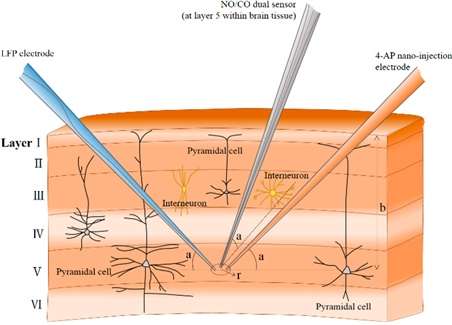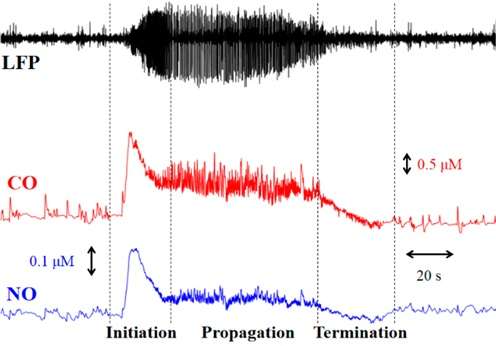CO/NO dual sensor for real time brain event observation

Inside our brains nerve cells signal each other using neurotransmitters including carbon monoxide (CO) and nitric oxide (NO) gases. Besides sharing a number of biological and chemical characteristics, CO and NO work together in regulating many physiological processes including vasodilatation, and immune reaction. Accurate and quantitative measurements of their physiological levels have been seen to result in meaningful findings and the focus of many previous studies. However their similarities have prevented such effort from cracking the entangled bond between CO and NO.
A research team from the Center for Neuroscience Imaging Research within the Institute for Basic Science Center (IBS) has devised a precise and fast responding tool that for the first time, enables completely separate and simultaneous, in-vivo measurements of CO and NO gases. The IBS team has monitored their levels in real time during a seizure event and confirmed that CO and NO are closely involved in the activation of neuronal cells.
The dual sensor is an amperometric microdevice, which is an electrical detection tool that is able to discern one specific molecule in a pool of many substances and count its concentration. What makes this so special is that the IBS device packs two separate sensors–one for CO, the other for NO exclusively–which can record in real time into a 300-µm probe, roughly twice the diameter of a human hair.
The probe is a construction of a 76-µm and a 50-µm platinum wires encased in thin, pulled glass capillary. The sensing tips of the probe are made of one gold and one platinum layers electroplated onto platinum substrates electrochemically etched to create recessed pores, resulting in a greater surface area (thus a higher sensitivity) for CO/NO detection. The fluorinated xerogel covering the tip prevents other biological interferents from obstructing the probe and allows the CO/NO gases to pass through selectively.

With miniaturized size and tapered needle-like shape, the dual sensor allowed the IBS team to record CO/NO within tissue during an acute seizure. Immediately after probe insertion, the IBS team was able to monitor almost dynamic changes in CO/NO levels.
Seizures have three distinct phases: initiation, propagation and termination. The dual sensor probe was able to record clearly defined changes in CO/NO levels which changed in accordance to the seizure's phase changes.
Dr. Minah Suh of the research group said, "Subsequent further study needs to be performed for the clarification of a correlation between each seizure type and the associated pattern of CO/NO changes." Dr. Suh added "Further studies will help to give more insights into the function and response of these neurotransmitters, laying the foundation for therapeutic applications for neuronal diseases."

More information: Yejin Ha et al. Insertable Fast-Response Amperometric NO/CO Dual Microsensor: Study of Neurovascular Coupling During Acutely Induced Seizures of Rat Brain Cortex, Analytical Chemistry (2016). DOI: 10.1021/acs.analchem.5b04288
Journal information: Analytical Chemistry
Provided by Institute for Basic Science



















